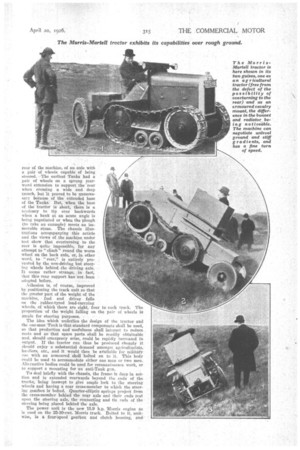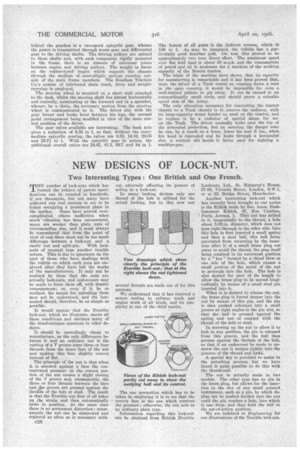FROM FARM TO BATTLEFIELD.
Page 10

Page 11

Page 12

If you've noticed an error in this article please click here to report it so we can fix it.
The Agricultural Tractor to Become the One-man Tank in War-time. Standard Components the Basis of a Varied Range of Machines.
TRUE, the horse (in his day) when war broke out was wont to be ruthlessly torn from the peaceful surroundings of the farm, where he hauled the plough through the stubble or fallow land and, in due season, the harrow and the mower and binder, alternating these soothing occupations with the greater excitement of taking the cart loaded with produce to the market, with the terrible possibility of a visit to the railway siding for a load of manure to cart back But, on reaching the war front, he was never taken to the cavalry lines or allowed to participate in a charge with the lance or the sword, nor heard the crack of the carbine a few inches above his head. For him was the humdrum and prosaic work of hauling stores and ammunition and, if he were an exceptional beast, of a trick with the guns.
If Major Martell's ideas fructify, however, the agricultural tractor of the future (of a type designed for eonver
sion) will be the motive power of the cavalryman, bearing an armoured screen for his protection and enabling him to cross broken country in pursuit of his enemy with even more surefootedness than could be asked or expected of the horse.
Major Martell took a touring car chassis with a Maxwell engine and a Roadless-Traction track unit and made an experimental " one-man Tank," and then invited the Mechanical Transport Section of the War Office to watch it at work. It seemed able to tackle any work demanded of it, it was free from certain defects that had hitherto attached to the tractor as devised for agricultural work on fiat lands and, therefore, as it need not be an expensive proposition it seemed to the officers of the Department to have possibilities. The War Office had already had some
dealings with Morris Commercial Cars, Ltd., which had produced chain-track vehicles specially devised to meet Army requirements, and that company was approached with the proposition to design and manufacture an experimental machine of the type. Mr. Cannel, the general manager of the company, at once saw that, quite apart from the military field, there was scope for such a machine in civilian use, and accordingly set to work to produce the Morris-Martell one-man Tank and its counterpart, or, rather, basis, the Morris tractor. Two machines, one equipped as a tractor and the other as the new one-man Tank, have recently undergone a trial in the presence of the War Office with very promising results, and its civilian utility would now seem to be unquestioned.
The fundamental feature of the design, wherein the Morris tractor differs from any forerunner, is the new disposition of the weight brought about by the use, at the
rear of the Machine, of an axle with a pair of wheels capable of being steered. -The earliest Tanks had a pair of wheels on a sprung rearward extension to support the 'rear when crossing a wide and deep trench, but it proved to be unnecessary because of the extended base of the Tanks.. IAA, when the base of the tractor is short, there is a tendency to tip over backwards when a bank at an acute angle is being negotiated or when the plough (to take au example) meets an immovable stone. The chassis illustrations accompanying this article and the views of the machine under test show that overturning to the rear is quite, impossible, for any attempt to " climb " round the worm wheel on the back axle, or, in other word, to "-rear,'! is entirely prevented by the non-driving but steering, wheels behind the driving axle. It seems rather strange, in fact, that this rear support has not been adoptedbefore.,
Adhesion is, of course, improved by positioning the track unit so that the greater part of the weight of the machine, • fuel and driver falls on the rubber-tyred load-carrying
wheels, of which there are eight,four to each track. The proportion of the weight falling on the pair of wheels is ample for steering purposes.
The idea which • underlies the design of the tractor and the one-man'Tank is that standard Components shall be used, so that production and usefulness shall interact to reduce . Costs and so that spare parts shall be readily obtainable and, should emergency arise, could be rapidly increased in output.. If the. tractor can thus be produced cheaply it should enjoy a substantial demand amongst agriculturists, hauliers, etc., and it would then be addilable for military use with an armoured shell bolted on to it. This body could be used to accommodate either one man or two men. Alternative bodies could be used for reconnaissance work, or to support a mounting for an anti-Tank gnu.
TOI deal briefly with the chassis, the frame is deep in section and is extended rearwards beyond the ends of the tracks, being inswept to give ample lock to the steering wheels and having a rear cross-member to which the steering gearbox is bolted. Quarter-elliptic springs' project from the cross-member behind the rear axle and their ends rest upon the steering axle the connecting and tie rods of the steering being placed behind the axle.
The power unit is the new 15.9 h.p. Morris engine as is used on the 25-30-cwt. Morris truck. Bolted to it, unitwise, is a four-speed gearbox and clutch housing, and-
behind the gearbox is a two-speed epicydic gear, Whence the power is transmitted through worm gear and differential gear to the driving shafts. The driving pulleys are splined to these shafts and, with each component rigidly mounted in the frame, there is an absence of universal joints between engine and driving pulleys. The weight is borne on the rubber-tyre& bogies which support the chassis through the medium of semi-elliptic springs running outside of the main frame members. The Roadless Traction Co.'s system of lubricated chain track, drive and weightcarrying is employed.
The steering wheel is mounted on a short stub attached to the dash, whilst the steering shaft lies almost horizontally and centrally, terminating at the forward end in a sprocket, whence, by a chain; the necessary motion from the steering wheel is communicated to it. The driver sits with the gear levers and brake lever between his legs, the normal pedal arrangement being modified in view of the more central position of the driver.
The gear ratios available are interesting. The back axle gives a reduction of 8.33 to 1, so that, without the intermediate epieyelic gearing, the ratios are 8.33, 14.10, 20.05 and 28.71 to 1. With the epieyclic gear in action, the additional overall ratios are 24.45, 41.3, 58.7 and 84 to 1. The lowest of all gears is the indirect reverse, which is 109 to 1. As may be imagined, the vehicle has a particalarly good drawbar pull. On test, this proved to be approximately two tons direct effort. The maximum speed over flat field land is about 30 m.p.h. and the consumption of petrol and oil is moderate for a machine of the working capacity of the Morris tractor.
The trials of the machine bare shown that its capacity for manceuvring is remarkable and it has been proved that, were the driver of a Tank intent on running down a man in the open country, it would be impossible for even a well-trained athlete to get away. It can be turned in an extraordinarily small circle, and should prove a valuable speed arm of the Army.
The only alteration necessary for converting the tractor chassis to a Tank chassis is to .remove the radiator, with its large-capacity water header as used on the tractor, and to replace it by a radiator of special shape for also on the Tank. The dther normally looks over the top of the armoured protection, but on entering the danger zone he can, by a touch on a lever, lower his seat 6 ins., when his head is concealed and he looks through a horizontal slot, a vertical slit beside it being used for sighting a machine-gun.
































